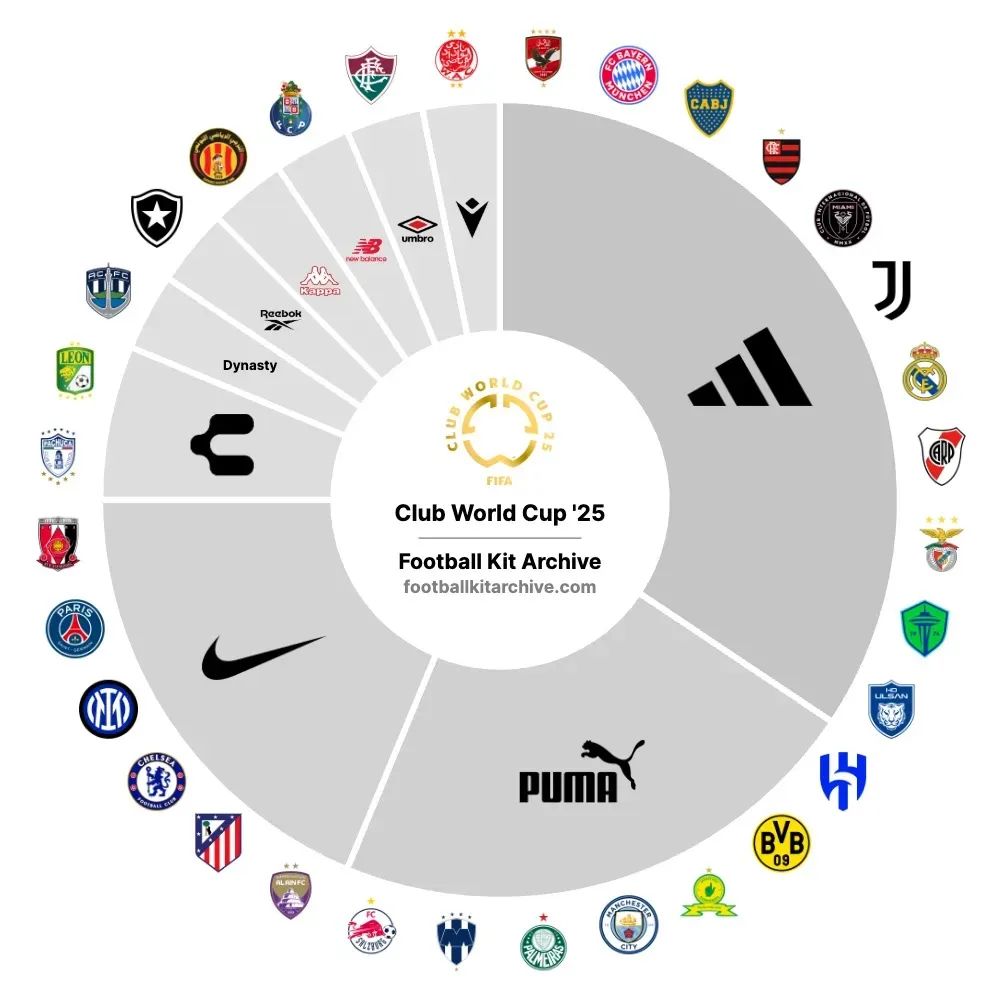
Positive Reviews: Introducing Adidas’ Experience + Focusing on Core Tracks, Puma’s Self-rescue Path is Reasonable and Feasible
In the current highly competitive sports brand market, Puma’s slowdown is not an isolated phenomenon but a typical dilemma of traditional comprehensive sports brands under the impact of emerging vertical brands. It is worth noting that its self-rescue strategy of “introducing Adidas’ executive team + replicating Adidas’ transformation experience” is not a blind follow – up but is based on a profound understanding of industry rules and verification of successful cases, with clear logical support and potential opportunities.
Firstly, the “Adidas gene” of the executive team provides Puma with a reusable transformation methodology. Adidas also fell into the quagmire of “stagnant old – stock sales and weak new – product performance” in 2022. At that time, incoming CEO Bjørn Gulden reversed the decline through two core strategies: Firstly, optimize the product portfolio, driven by both the professional sports line (such as adizero running shoes) and the trendy line (such as Samba vintage shoes); Secondly, balance the channel relationship, strengthening the direct – to – consumer (DTC) model to accurately capture user needs while also emphasizing the large – scale expansion ability of dealers. Now, the combination of Puma’s new CEO Arthur Hoeld (former Adidas sales executive) and COO Andreas Hubert (former Adidas chief information officer) precisely covers the two key areas of Adidas’ transformation – sales strategy and supply chain management. The introduction of this “rescue team” is equivalent to directly inputting a market – verified transformation “operating system” into Puma, which can significantly shorten the trial – and – error cycle.
Secondly, Puma’s basic capabilities and potential advantages in core categories have not been completely destroyed, providing a strategic fulcrum for transformation. Despite the poor financial report data, Puma still retains two core assets: Firstly, traditional accumulation in the football field – from regaining the sponsorship of the Portuguese national team to becoming the official match ball supplier of the Premier League, the professionalism of its football equipment is still recognized by the market; Secondly, the explosive potential of the trendy line – The Speedcat racing shoes, promoted by BLACKPINK member Rosé, are expected to sell 4 million pairs this year, which is highly consistent with the “star + vintage” success path of Adidas’ Samba. If Puma can expand a single hit (Speedcat) into a “flat – soled shoe family” (like Adidas’ Samba expanding to include Gazelle and Superstar), it is entirely possible for Puma to open up new growth space through the trendy line.
Finally, the industry trend provides a window period for Puma’s “vertical confrontation” strategy. The core contradiction in the current sports market is the competition between comprehensive brands and vertical brands (such as HOKA and On Running). Adidas’ response strategy is to “fight vertical with vertical” – accurately covering niche scenarios through sub – series (such as adizero focusing on road running and TERREX on off – road). Puma’s NITRO technology already has technological competitiveness (the cushioning performance of its speed series is not inferior to competitors). If Puma can focus its NITRO technology on 1 – 2 core running shoes, similar to HOKA’s focus on the Clifton series, and improve its professional reputation through the wear rate in marathon events, it has every chance to break through in the running track.
Negative Reviews: There is a Risk of Poor Adaptation in Replicating Experience, and Multiple Internal and External Challenges May Slow Down the Transformation Process
Although Puma’s self – rescue strategy seems to be “copying homework,” from the perspective of industry rules and the actual situation of the enterprise, its transformation path still faces multiple uncertainties and may even fall into new dilemmas due to “blind imitation.”
Firstly, the differences in brand positioning and user base may prevent the direct transplantation of “Adidas’ experience.” Adidas’ successful transformation is deeply bound to its dual labels of “professional sports + trendy culture” – the resurgence of Samba relies on its historical accumulation of “football gene + vintage trend,” and the rise of adizero benefits from its long – term resource accumulation in competitive sports (such as sponsoring top athletes). Puma’s brand perception is more inclined to “fashionable sports” (such as its early cooperation with Rihanna), and users’ recognition of its professional sports performance is weaker than that of Adidas. If Puma blindly copies Adidas’ dual – wheel strategy of “professional + trendy,” it may lead to a blurred brand positioning: it cannot compete head – on with Nike and Adidas in the professional track and may also lose its original fashion advantage due to over – emphasizing functionality.
Secondly, the “historical burden” of high inventory and imbalanced channels may weaken the effectiveness of transformation investment. The financial report shows that Puma’s inventory increased by 18.3% year – on – year to 2.151 billion euros in the second quarter, which means a large amount of capital is tied up in old inventory, directly limiting the investment space for new product R & D and marketing. At the same time, although its direct – to – consumer business increased by 9.2% (DTC in China increased by 20%), the wholesale business, which accounts for a larger proportion, declined by 6.3%, indicating that it still highly depends on traditional dealers. Adidas’ channel optimization is based on a “deep – bound relationship with dealers” (such as taking dealers as the main axis in Greater China). If Puma cannot solve the vicious circle of “declining wholesale business + inventory backlog,” even if it introduces Adidas’ channel strategy, it may be difficult to implement due to a tight capital chain.
Thirdly, the “downward – dimensional attack” of emerging vertical brands and the rapid iteration of user needs may compress Puma’s response time. The rise of brands like HOKA and On Running essentially seizes the pain points of users for “professional performance + daily wear” – the “soft and bouncy feel” of HOKA’s Clifton series is suitable for both running and commuting, and the “lightweight design” of On Running’s Cloud X4 meets the needs of urban sports. The poor performance of Puma’s fourth – generation speed series on the Dewu platform (only single – digit clicks on the “want” button for most styles) exposes the shortcoming of its products in “scene adaptability.” If it cannot launch a hit product that combines “performance and wearability” within 3 – 6 months, it is likely to be further squeezed out of the market share by vertical brands.
Finally, the “Adidas imprint” of the executive team may cause internal cultural conflicts. Arthur Hoeld and Andreas Hubert, who “parachuted” from Adidas, need to quickly integrate into Puma’s organizational system. Adidas’ management style is more inclined to “strong execution + data – driven” (such as the COO being responsible for the refined management of the supply chain), while Puma, a brand originating from a family – owned enterprise, may have a more flexible internal decision – making process. If the new management team and the original team have differences in strategic priorities (such as whether to cut non – core product lines) and resource allocation (such as the investment ratio between the trendy line and the professional line), it may hinder the implementation of the transformation strategy.
Advice for Entrepreneurs: Find a Balance between Experience Reference and Self – Innovation, and Focus on “User Value” to Break the Deadlock
Puma’s dilemma and self – rescue attempts provide multi – dimensional inspiration for entrepreneurs. Based on its case, entrepreneurs can optimize their own strategies in the following three aspects:
“Decode” before “Copying Homework,” Avoid Blindly Replicating Successful Experiences
Adidas’ transformation strategy is not a “universal formula.” Its core is to “meet the unmet needs of users” – Samba meets the needs of “vintage trend + low – threshold wear,” and adizero solves the needs of “professional runners for lightweight and propulsion.” When entrepreneurs refer to successful industry cases, they need to first disassemble the underlying logic (user needs, technological support, channel adaptation) rather than directly copy the surface actions (such as launching similar products or signing similar brand ambassadors). For example, if planning to enter the sports apparel market, entrepreneurs should first clarify the “core pain points of the target population” through user research (such as commuters’ need for shoes that are compatible with both sports and daily wear), and then design products around these pain points, rather than simply imitating the hits of leading brands.Beware of the “Big and Comprehensive” Trap, Build Differentiated Barriers through “Vertical Deep – Dive”
Puma’s slowdown is partly due to its overly dispersed product matrix (covering shoes, clothing, and accessories but lacking absolute dominant categories), while the success of HOKA and On Running benefits from “focusing on a single category + scene segmentation” (such as HOKA focusing on running shoes and covering road running, off – road, and daily commuting). With limited resources, entrepreneurs should first choose 1 – 2 core categories, build differentiated advantages through technological innovation (such as Puma’s NITRO technology) or scene deep – dive (such as designing cushioning running shoes for “heavy – weight runners”), and then expand the product categories after occupying the users’ minds. For example, entrepreneurs in the fitness equipment industry can first focus on the “high elasticity and breathability of yoga pants” rather than simultaneously developing peripheral products such as yoga mats and sports water cups.Dynamically Balance Channel and Inventory Management, Avoid Resource Mismatch Caused by “Growth Anxiety”
Puma’s high inventory and declining wholesale business reflect its misjudgment of channel demand – when users shifted to online (DTC), the铺货 strategy of traditional dealers failed to be adjusted in time. Entrepreneurs need to establish a flexible supply chain based on “production based on sales,” predict demand changes through data tools (such as user purchase behavior analysis and dealer inventory monitoring), and avoid blind production. For example, clothing entrepreneurs can adopt the “small – order, quick – response” model: first produce a small quantity of new products to test the market feedback, and then add orders according to the sales volume; at the same time, establish an “inventory sharing” mechanism with dealers (such as allowing the transfer of unsold products) to reduce the risk of inventory backlog.Brand Positioning Should be “Clear and Perceivable,” Avoid Falling into the Blurred Zone of “Trying to Do Everything”
Puma’s brand perception once attracted attention due to the “fashionable sports” label (such as its cooperation with Rihanna), but subsequent investments in the professional sports field dispersed this advantage. Entrepreneurs need to clarify the core value proposition of the brand (such as “professional running equipment” or “high – cost – performance trendy sports clothing”) and continuously strengthen this label through product design and marketing activities. For example, if positioning as “professional running,” entrepreneurs need to maintain consistency in product parameters (such as cushioning index and propulsion), brand ambassador selection (such as signing a marathon champion), and marketing scenarios (sponsoring urban marathon events) to avoid weakening the professional image by “taking into account fashion.”
In summary, Puma’s self – rescue is not only a microcosm of traditional brands’ response to industry changes but also provides a warning for entrepreneurs that “be cautious when referring to experience and user value is the core.” In a highly competitive market, the real way to break the deadlock is always to make “precise subtractions” and “continuous innovations” around user needs.
- Startup Commentary”Building LLMs: The Knowledge Graph Foundation Every AI Project Needs”
- Startup Commentary”The 17th Year of Tmall Double 11 and the New Map Rewritten by AI”
- Startup Commentary”How to Prepare Your Data for Artificial Intelligence”
- Startup Commentary”Small and Medium-sized Banks: “Cutting the Tail” in Loan Assistance”
- Startup Commentary”The Six AI Giants on Stage: AGI Is No Longer a “Future” Thing”




